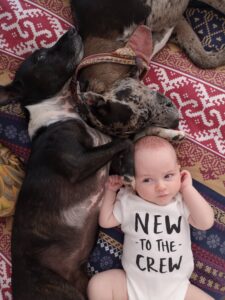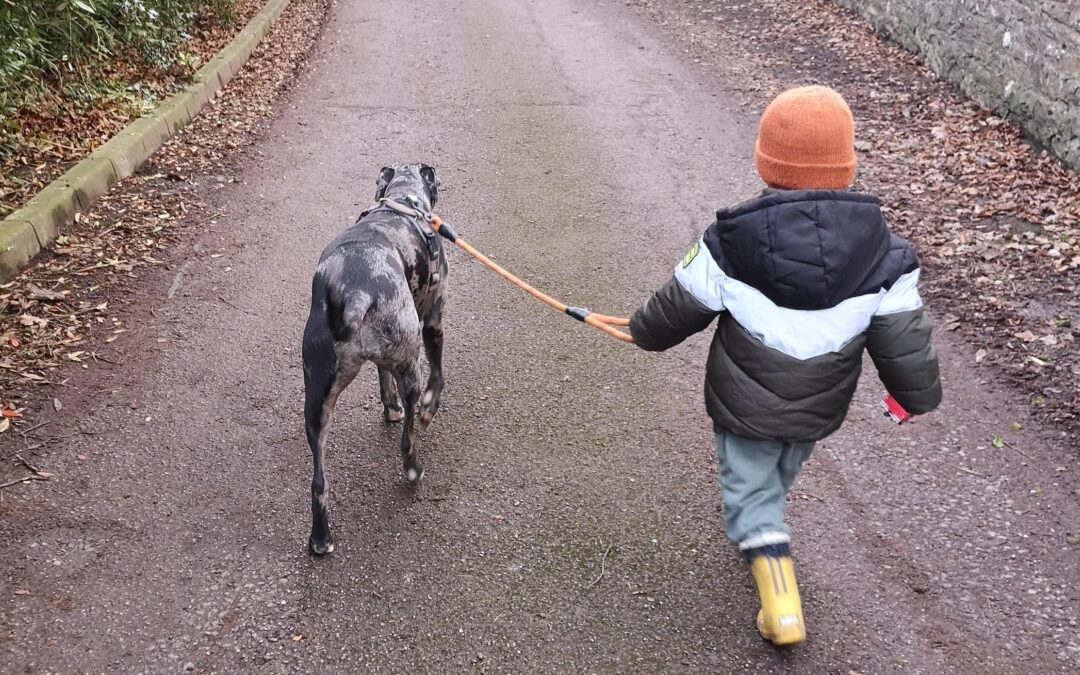There are lots of blogs and sources out there with information on how to introduce your dog to a baby or how to desensitise your dog to the arrival of a small, loud human, but I thought I would write a bit more about some of the long-term behaviours that will help you and your dog adjust to life with a child.
When families find they are struggling with their dog, it is usually either the dog and child are having trouble co-existing or because the dog has no idea that it is expected to behave differently to how it was before. The dog doesn’t understand that its once tolerated alert barking is now waking the child multiple times a day, or that all the fun new toys and teething rings are not for them to play with. With a bit of forethought and some training prior to the babies’ arrival, a lot of this difficulty can be avoided.
Below are some of the behaviours that might help your dog in the long run understand when is expected of them.
You want to start teaching and enforcing these behaviours as soon as you are expecting a baby – the longer they have been embedded in the dog’s life, the more normal they will be for them.
 Jumping Up – you will need to train your dog not to jump up at people – to ensure the dog doesn’t jump up at someone holding the baby.
Jumping Up – you will need to train your dog not to jump up at people – to ensure the dog doesn’t jump up at someone holding the baby.
Furniture boundaries – things like not jumping onto your lap on the sofa – sometimes this can be a no sofa rule or just a new command is introduced that they are only allowed up once invited. If you have a specific nursing chair, it may be able be useful to make that a no dog zone.
A ‘no go zone’ – this could be just a specific blanket or a whole room where the dog cannot go- this gives you a safe space your baby can explore and roll around without danger of them annoying the dog or vice versa.
Chewing – If your dog is a chewer you will need to address the root cause for this and train them to only chew appropriate dog safe things, this will avoid them chewing baby/kids toys that often look a lot like their own things.
Leave it – there are going to be lots of new and interesting things appearing around your house as your new baby grows up, so having a good leave it command for if your dog is tempted to explore these things is important.
Settle – there is going to be a lot of times when you will need your dog to feel safe and comfortable to spend time on its own and give you space to address the babies needs. If you dog has a good calming protocol and ‘place’ or ‘bed’ command, then this again is useful if you need them to move away to settle for any reason.
As your child grows, it is important to also teach them that when the dog moves to their own space, they must not be disturbed, this allows the dog space to move away to a safe space if they are not comfortable with the way the child is behaving.
Out and About
If you want to be able to keep your dog involved in your lifestyle as your child grows, then you will need to ensure that their behaviour out and about is easily manageable. When you have a toddler running in all directions, you often won’t have the capability to also manage a dog that doesn’t recall or pulls on the lead.
Loose leash – teaching your dog to walk politely on the lead is essential, and particularly alongside a pushchair if you will be using one often. It’s not only annoying if your dog is pulling you around but also dangerous if it could pull a baby over.
Stay or wait – there are lots of times when you have a baby or toddler when there is a lot of faffing about and you need to get things sorted, you want your dog to understand that they will have to wait patiently while this occurs. This might be in the boot of the car or just while you are out and about, trying to sort out a baby while your dog is whining and pulling to get somewhere will just build frustration for you both.
Recall – you don’t want to be chasing your dog around a field to get them back on a lead or letting them get in trouble with another dog if they have run up to it when you also have a baby or toddler to attend to.
These behaviours are just some general ones that I have seen have become problems over time, there may be other things that your family will need, or some of these that won’t be a problem for you, make your own training list for you and your dog!

